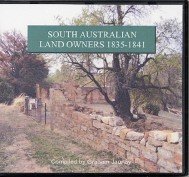Land ownership in South Australia
In 1834 before the province was proclaimed on 28 Dec 1836
it was assumed that all land was owned by the government
who could dispose of it as it saw fit to British subjects
at not less than 12 shillings an acre.
The ownership of land in South Australia arose via a number
of processes
1. squatting on vacant land. (the land was in fact
owned by the indigenous people of South Australia)
2. as a gift from the Crown.
3. by purchase prior to 1858 and registration of the
deeds at the GRO.
4. by purchase from 1858 under the provisions of the
Real Property Act that gave a Title.
5. on a perpetual lease from the Crown.
Before 1858
By common law, prospective landowners needed to prove their
ownership of a particular piece of land back to the earliest
grant of the land by the Crown to its first owner. By registering
land ownership with the General Register
Office (GRO) under the deeds registration system
some legal protection in regard to ownership was afforded.
Although a register of who owned what land was maintained,
it was unreliable and could be legally challenged. The limits
of the deeds registration system meant that transfers of
land were slow, expensive, and often new owners were unable
to create certainty of ownership.
Acres within the proposed city of Adelaide sold before the
site of the city was even determined effectively were sold
by the government (although it did not exist at the time)
were purchased under this scheme but of course the ownership
in this case was secure as these purchasers were the first
owners (italics are used here because we know that the land
was owned by the indigenous people). The purchase of a city
acre entitled the purchaser to buy 80 acres of rural land
for farming. The funds raised form these sales were used
to pay the fares of the working classes who sought assisted
passage. This concept was known as the Wakefield Scheme
as was the basis for the establishment of South Australia.
Within this period we have a group of people who gained
special privileges because they showed confidence in the
proposed colony and purchased land as a prelude to establishing
the province. It was deemed that land should be sold in
small sections (ideally about 80 acres) at a cost sufficient
to fund the migration of labourers. The South Australia
Colonisation Act 1834 appointed commissioners, called The
Colonisation Commissioners for South Australia, to oversee
the sale and leasing of land in South Australia to British
subjects. The Act required that the colony was to be self-sufficient
and a £20,000 surety had to be created and £35,000
worth of land had to be sold in the new colony before any
settlement was permitted. These conditions were fulfilled
by the end of 1835. The Act specified the minimum price
of land at twelve shillings per acre regardless of the quality.
The money raised by the sale and leasing of land constituted
what was called an Emigration Fund which was to cover to
the cost conveying immigrant labourers and their families
from Great Britain and Ireland.
The survey and staking out of sections by William Light’s
survey teams for the Adelaide town acres began on 11 January
1837 and was completed on 10 March; the first allocation
of purchased land being on 23 March. Surveys of country
lands on the Adelaide plains commenced in April 1837. By
November about 24,000 hectares had been completed. The first
437 purchasers in England of Preliminary Land Orders were
entitled to priority selection by ballot conducted on 28
March 1838 of a town acre and a 134 acre country section—cost:
£81-0-0 (effectively 12 shillings an acre). These
were surveyed in the prime locations adjoining the diagonal
routes and on the best soils east to the foothills.
Persons purchasing land in South Australia from 1835 to
1841 are now available together with details of their purchase
on a CD that can be seen at major family history libraries.
From 1858
The Real Property Act (Torrens Title) 1858 gave security
and simplicity to all dealings with land by providing for
the registration of a title listing all parties with an
interest in the property. By this system the registered
owner obtains a title secure against everyone whose claim
does not appear upon the registry.
From 1872 an Act was passed settlers with only a small amount
of capital an opportunity of settling upon the lands of
the Crown. The principles of closer settlement were introduced
by the Closer Settlement Act of 1897, whereby large tract
of pastoral grazing land in areas deemed suitable for cropping
were compulsorily acquired, subdivided and sold or leased.
This was necessary because in spite of the Wakefield Scheme
of small parcels of 80 acres of rural land for farms (that
turned out to be inappropriate in SA conditions), most land
was initially taken up by large landholders for grazing
purposes effectively locking out the smaller cropping farmer.
After World War I the Minister for Repatriation could acquire
by purchase, either by agreement or compulsorily, land under
any tenure for the purpose of the settlement of discharged
soldiers. The Governor could also set apart Crown lands
for allocation to discharged soldiers. This land was subdivided
into blocks, and offered to them on agreements to purchase
or lease including perpetual leases. The Minister could
remit any payment.
|